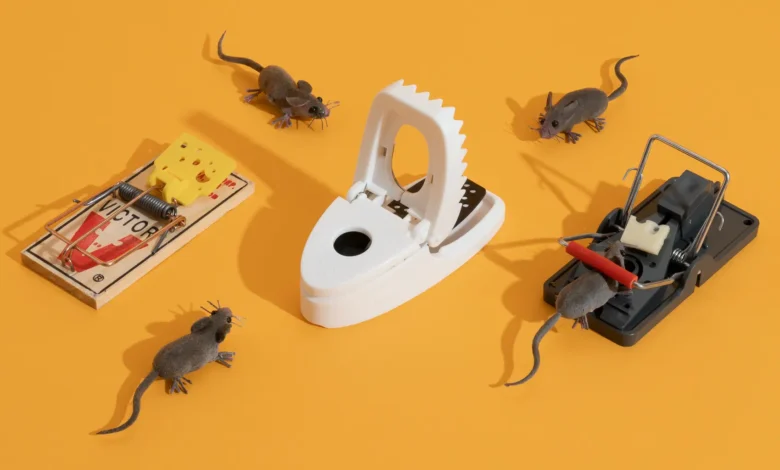Mouse Trap: Essential Tips for Setting and Using It Properly

mouse trap Mice infestations are a common nuisance for homeowners and businesses alike. These tiny rodents may seem harmless, but they can cause significant damage to property, contaminate food, and spread disease. While some people may be hesitant to deal with mice, it’s important to address infestations promptly with effective rodent control methods. One of the most popular and reliable ways to eliminate mice is through the use of a mouse trap. However, with so many different types available, it can be difficult to choose the right one for your situation.
In this comprehensive guide, we will explore everything you need to know about mouse trap. From understanding the different types to choosing the right trap for your needs, we’ll break down the entire process to ensure that you can effectively rid your home or business of mice. Additionally, we’ll offer tips on how to prevent future infestations and maintain a clean, mouse-free environment.
Types of mouse trap: Which One is Right for You?
When it comes to mouse trap, there are several different types available, each with its unique advantages and disadvantages. To help you choose the best one for your needs, let’s take a closer look at the most popular options.
Snap Traps
Snap traps are the traditional mouse trap that have been used for decades. They feature a spring-loaded mechanism that, when triggered, snaps shut with force, killing the mouse instantly. These traps are highly effective and can be found at most hardware stores.
One of the main advantages of snap traps is their speed and efficiency. They work quickly, offering a fast solution to eliminating mice. Additionally, they are inexpensive and can be used multiple times, making them a cost-effective option for many people. However, snap traps do come with some downsides. They can be dangerous to pets or children if not placed correctly. If a pet or small child triggers the mouse trap, it could lead to injury. Additionally, snap traps are not as humane as other methods, as they kill the mouse immediately, which may be a concern for animal lovers.
Glue Traps
Glue traps are another option that works by capturing mice when they walk across the trap’s sticky surface. Once a mouse steps onto the trap, it becomes stuck and unable to escape. These traps can be effective for catching mice, especially in areas where snap traps may be too risky.
One of the main advantages of glue mouse trap is their ease of use. They require no baiting and can be placed almost anywhere in the home. Additionally, they can catch multiple mice at once, which can be beneficial if you’re dealing with a large infestation. However, glue traps have several significant downsides. First, they are not a humane solution, as the mouse will eventually die from dehydration, stress, or exhaustion. Secondly, they can be messy, and cleaning up the trapped mouse can be unpleasant. Lastly, glue traps are not as effective as snap traps in areas with high mouse activity, as mice may avoid them or get stuck on the edges rather than in the center.
Electric Traps
Electric mouse trap are an innovative solution for dealing with rodent infestations. These traps use a high-voltage electric shock to kill mice instantly when they enter the trap. The trap is baited with food, and when the mouse enters, it triggers the electric mechanism.
Electric traps are a humane option for those who are concerned about using snap traps or glue mouse trap . The shock kills the mouse instantly, minimizing pain and suffering. Additionally, electric traps are reusable, making them more environmentally friendly and cost-effective in the long term. However, these traps require batteries or a power source, and they tend to be more expensive than traditional options. Another consideration is that electric traps may only work for small to medium-sized mice, as larger rodents may be able to avoid the trap altogether.
Humane Traps
Humane traps, also known as live-catch traps, are designed to capture mice without killing them. These traps feature a small, enclosed space where the mouse is trapped once it enters. The mouse can then be safely released back into the wild.
Humane traps are ideal for those who want to avoid killing mice but still need to address an infestation. They are relatively easy to use and can be placed in areas where mice are active. Additionally, humane mouse trap are safe for pets and children, as they pose no risk of injury. However, humane traps have their drawbacks. First, they require more effort, as the captured mouse must be relocated far from your home to prevent it from returning. Additionally, these traps can be less effective in areas with high mouse activity, as they may require more frequent checking and maintenance.
Multi-Catch Traps
Multi-catch traps are designed to capture several mice at once. These traps feature a large chamber with a one-way door that allows mice to enter but prevents them from escaping. Once the mice are inside, they can be safely removed and relocated.
One of the main benefits of multi-catch traps is that they can capture several mice at once, making them an efficient choice for large infestations. These mouse trap are also humane, as they do not kill the mice. However, multi-catch traps can be bulky and more difficult to place in tight spaces. Additionally, they require frequent checking, as mice can become stressed if left inside for too long.
How to Choose the Right Mouse Trap for Your Situation
Now that you know about the different types of mouse trap, it’s important to choose the one that best fits your situation. Here are some factors to consider when making your decision.
Assessing Your Mouse Problem
The first step in choosing the right mouse trap is to assess the severity of your infestation. If you’re dealing with a small number of mice, a simple snap trap or glue trap may suffice. However, if you have a larger infestation, you may need to use multiple traps or opt for a multi-catch or electric trap. Additionally, if you’re noticing signs of mice in several areas of your home, a more robust solution may be necessary.
Considering Safety and Health
When choosing a trap, it’s essential to consider the safety of your family, pets, and the environment. If you have small children or pets in your home, you’ll want to avoid mouse trap that could pose a danger. Snap traps and electric traps, while effective, can be hazardous if accidentally triggered. Humane traps, on the other hand, are safe for pets and children but may require more frequent monitoring.
Additionally, consider the health risks associated with mice. Mice are known to carry diseases such as Hantavirus, leptospirosis, and salmonella. If your home is prone to rodent-borne illnesses, it’s crucial to choose a trap that is effective at eliminating mice quickly and efficiently.
Environment and Location
Where you place your traps will also influence the type of mouse trap you choose. If you’re trying to catch a mouse in a confined space, such as behind furniture or in a narrow gap, a snap trap or glue trap may work best. On the other hand, if you need to catch mice in an open area, a multi-catch or electric trap may be more effective.
In areas with high foot traffic, such as kitchens or hallways, consider using traps that are easy to set up and monitor. Humane traps and multi-catch traps are excellent for these areas, as they allow you to capture multiple mice at once without worrying about the trap being triggered too early.
Budget Considerations
Finally, consider your budget when selecting a mouse trap. Snap traps and glue traps are inexpensive and widely available, making them an attractive choice for people on a budget. Electric traps and multi-catch traps tend to be more expensive, but they may offer long-term value by catching multiple mice or being reusable. Determine how much you’re willing to invest in rodent control and choose the trap that fits your needs.
Step-by-Step Guide to Setting and Using a Mouse Trap
Once you’ve selected the right mouse trap, it’s time to put it to work. Here’s a step-by-step guide on how to set and use your trap effectively.
Preparing the Trap
Before setting your trap, it’s important to prepare it properly. If you’re using a snap trap, bait the trap with peanut butter, cheese, or seeds. If you’re using a humane trap, place a piece of fruit, seeds, or peanut butter inside the cage. Avoid using overly large amounts of bait, as it could prevent the trap from functioning properly.
For glue traps, no baiting is required, as they work by capturing mice who wander across the sticky surface. Place the mouse trap in areas where mice are active, such as along walls or near food sources. Make sure to follow the manufacturer’s instructions for optimal performance.
Setting the Trap
When setting your trap, be careful to place it in a location where mice are likely to pass by. Mice tend to travel along walls and in dark, hidden spaces. Place your traps in these areas to maximize their effectiveness. Be sure to set the trap properly, especially with snap traps, as improper placement can prevent the trap from triggering.
Checking the Traps
Once your traps are set, check them regularly. For snap traps, this may involve checking them every few hours, especially during peak rodent activity. Humane traps should be checked at least once a day to ensure that the captured mouse is released promptly. Glue traps should also be checked regularly, as mice can become stuck for extended periods.
Disposal and Maintenance
Once a mouse is caught, dispose of it properly. If you’re using a snap trap or electric trap, dispose of the dead mouse in a sealed bag. For humane mouse trap, release the mouse at least a mile away from your home to prevent it from returning. Be sure to clean and maintain your traps as directed to ensure their longevity and effectiveness.
Preventing Future Mouse Infestations
After successfully dealing with a mouse infestation, it’s important to take steps to prevent future problems.
Seal Entry Points
One of the most effective ways to prevent mice from entering your home is by sealing potential entry points. Check for gaps around windows, doors, and foundation walls, and seal them with caulk or weatherstripping. Mice can squeeze through surprisingly small holes, so be thorough in your inspection.
Maintain Cleanliness
Keeping your home clean is crucial to deterring mice. Avoid leaving food out overnight, and clean up crumbs and spills promptly. Mice are attracted to food sources, so eliminating these can make your home less inviting.
Long-Term Solutions
In addition to mouse trap, consider using other rodent control methods, such as ultrasonic repellents or natural deterrents like peppermint oil. If you continue to experience mouse problems, professional pest control may be necessary to address the issue effectively.
Conclusion: mouse trap
Choosing and using the right mouse trap is a critical part of managing a rodent infestation. Whether you opt for snap traps, humane traps, or multi-catch traps, it’s important to consider your situation and select the best option for your needs. By setting and maintaining your mouse trap properly, and taking steps to prevent future infestations, you can ensure that your home or business remains free from mice. Don’t let rodents take over your space—act quickly, and enjoy a cleaner, safer environment.




